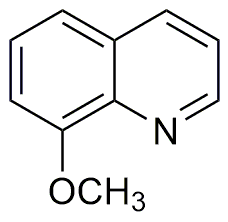8-Methoxyquinoline is widely utilized in research focused on:
- Analytical Chemistry: It serves as a reagent in the detection of metal ions, particularly in complexometric titrations, enhancing the accuracy of analytical results.
- Pharmaceutical Development: This compound is explored for its potential as an antimicrobial agent, providing a basis for developing new antibiotics in the fight against resistant bacteria.
- Material Science: It is used in the synthesis of organic light-emitting diodes (OLEDs), contributing to advancements in display technologies with improved energy efficiency.
- Biochemistry: 8-Methoxyquinoline acts as a fluorescent probe for studying cellular processes, aiding researchers in visualizing biological activities in real-time.
- Environmental Science: The compound is investigated for its role in the degradation of pollutants, offering solutions for environmental remediation efforts.
General Information
Properties
Safety and Regulations
Applications
8-Methoxyquinoline is widely utilized in research focused on:
- Analytical Chemistry: It serves as a reagent in the detection of metal ions, particularly in complexometric titrations, enhancing the accuracy of analytical results.
- Pharmaceutical Development: This compound is explored for its potential as an antimicrobial agent, providing a basis for developing new antibiotics in the fight against resistant bacteria.
- Material Science: It is used in the synthesis of organic light-emitting diodes (OLEDs), contributing to advancements in display technologies with improved energy efficiency.
- Biochemistry: 8-Methoxyquinoline acts as a fluorescent probe for studying cellular processes, aiding researchers in visualizing biological activities in real-time.
- Environmental Science: The compound is investigated for its role in the degradation of pollutants, offering solutions for environmental remediation efforts.
Documents
Safety Data Sheets (SDS)
The SDS provides comprehensive safety information on handling, storage, and disposal of the product.
Product Specification (PS)
The PS provides a comprehensive breakdown of the product’s properties, including chemical composition, physical state, purity, and storage requirements. It also details acceptable quality ranges and the product's intended applications.
Certificates of Analysis (COA)
Search for Certificates of Analysis (COA) by entering the products Lot Number. Lot and Batch Numbers can be found on a product’s label following the words ‘Lot’ or ‘Batch’.
*Catalog Number
*Lot Number
Certificates Of Origin (COO)
This COO confirms the country where the product was manufactured, and also details the materials and components used in it and whether it is derived from natural, synthetic, or other specific sources. This certificate may be required for customs, trade, and regulatory compliance.
*Catalog Number
*Lot Number
Safety Data Sheets (SDS)
The SDS provides comprehensive safety information on handling, storage, and disposal of the product.
DownloadProduct Specification (PS)
The PS provides a comprehensive breakdown of the product’s properties, including chemical composition, physical state, purity, and storage requirements. It also details acceptable quality ranges and the product's intended applications.
DownloadCertificates of Analysis (COA)
Search for Certificates of Analysis (COA) by entering the products Lot Number. Lot and Batch Numbers can be found on a product’s label following the words ‘Lot’ or ‘Batch’.
*Catalog Number
*Lot Number
Certificates Of Origin (COO)
This COO confirms the country where the product was manufactured, and also details the materials and components used in it and whether it is derived from natural, synthetic, or other specific sources. This certificate may be required for customs, trade, and regulatory compliance.


